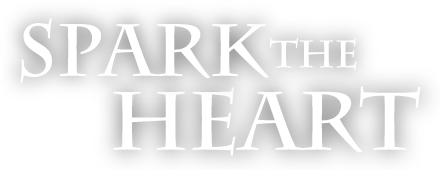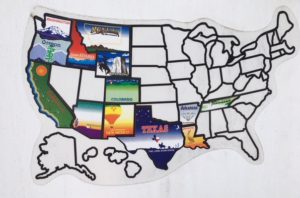Counting Blessings
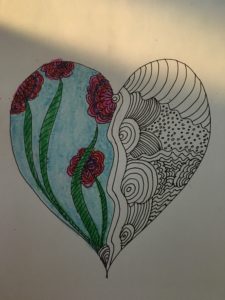
Blessings by Ruth Davis
Counting Blessings
Our volunteering gig at the refuge in New Jersey is officially over. I worked my last shift at the Visitor Information Center on Saturday, and it was a full and fulfilling day. We had 158 visitors and sold more duck stamps, park passes, and gift shop items than any other day I’ve been there. We loaned out binoculars, showed the wonderful video, and helped folks identify what birds they saw on Wildlife Drive. I enjoyed the women I worked with, and I even teared up on my walk home.
That night we went out for Rita’s ice cream with our neighbors who live down the street. We’ve had dinner with them twice and chat when we see each other walking our dogs. It’s been fun to connect with people in the neighborhood.

And now today, Sunday, is a readying day: laundry, more laundry, packing the mosquito tent, taking out the maps. Marika is on an all-afternoon birding boat tour to watch migrating hawks. I am so thrilled that she is doing this. She’s enjoying a day in nature and I can move at my own pace and get it all done.
In between laundry cycles, I’ve been thinking about all of the blessings of this time here. That those first few weeks were all about settling into working with very-different-than-me people, not having any control over how anything worked, and finding ways to share my insights and skills without expectations.
And then, finally appreciating the heart of the job: interacting with the visitors. I think working a shift with Marika really opened me up to engaging in conversations and exchanges, and providing a friendly, welcoming environment.

From that day on, I was able to focus on these connections even when I was working with someone who I didn’t really vibe with. The challenge was that, many days, there were only 25-40 visitors in the entire five-hour shift. So there was a lot of down time. But I found ways to make it work, and even did a few extra projects, like counting volunteer shirts and hats, tallying how many volunteers are under 35, and emptying the lending library into boxes for donation. Nothing very challenging, but it was the perfect backdrop for being here, exploring the area, and closing my Mac training business.

The big reason we chose to volunteer in New Jersey was so that Marika could spend time with her last living aunt. We spent a few nights in Philadelphia and I finally got to meet Marika’s cousins, and then Marika drove up several other weekends to overnight with her aunt.

I got together with sixteen cousins and my last living uncle, and bonded with my favorite cousin from when I was three years old.

We handled all kinds of RV repairs- the new air conditioner, the water leak (twice), and the leveling jacks that won’t go down. (The repair parts are on order and we’ll be swinging back through New Jersey at the end of October to get it fixed.)
We did some fun touristing, had a great week with a visiting friend, and we each relived moments from our childhood on the Jersey shore. We drooled over real east coast pizza, Philadelphia pretzels, New York bagels, cheese steaks, local summer produce, frozen custard, fried shrimp, and live lobster, steamed at the supermarket.

And I met a Facebook friend in real life and we went to the Elton John concert together.

We have been camped in a most beautiful secluded place on a lake in the woods, still in easy reach of great food, museums, and all of the necessities.

And we finally took a glorious sunset walk on the beach!

And now we are heading out on the road, as tourists, to explore the color-changing landscapes of New England, learn about the Industrial Revolution, and eat lots of lobster rolls.
Yes, it’s been a wonderful three months, and I am so grateful that we both love living this lifestyle.
Endings and Openings
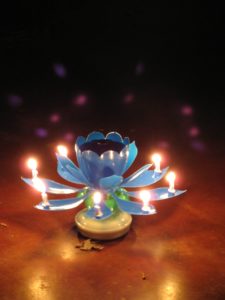
It’s a curious thing: I’m less than two weeks away from closing my Mac training business after 32 years, and a huge part of me thinks I should have my next website up and running by the end of the month.
So that I can catch my previous peeps while I still have their attention, and more important, because I think I have to have the next thing ready and in place.
But I don’t. In fact, I can’t.
Because I don’t even know what it is yet.
And so I am practicing what I ask my clients to do/not do: I am allowing the empty space to be gloriously empty, so that I can feel around in it, explore the corners, the edges, the round places, and allow the emptiness to speak and grow and create itself.
And of course, this perfectly coincides with our upcoming travels. We will be finishing our volunteering gig here on the Jersey shore at the end of the month, and traveling in New England and the mid-Atlantic states for the next 60 days, exploring, adventuring, meeting up with friends, and enjoying this RVing lifestyle.
One again, my outer life is reflecting my inner life, oh, so perfectly.
So when I start to get wound up in my future head, I just have to remember that this is a time for not knowing, for exploring and discovering and seeing what winks at me and my heart. It’s a time for trying new things, seeing with fresh eyes and having some FUN!
Adventures Around Atlantic City

It’s hard to believe that this is the last week in August, and that we’re only here on the New Jersey shore for another month. There are less shorebirds at the refuge, the ospreys have all fledged and, in the next few weeks, the waterfowl will be arriving for their winter layover. The marsh grasses are fading from their bright summer greens, and starting to show hints of gold and yellow. And a few leaves along the lake trees have already turned red.
We’ve been exploring more of the area with a visiting friend this past week, including a trip to Atlantic City to walk on the boardwalk. As a kid, our family would meet my Philadelphia relatives for a week at a hotel on the boardwalk. My cousin and I would spend most of the time in the hotel pool because we could only go to the beach with an adult, and my mother hated the sand and the sun. In the evenings, the families would take a walk along the boardwalk, and I’d stand against the railing watching the waves rolling far out in the ocean.
Very little is the same, 50 years later. The dunes have been built up so you can’t see the sand or the ocean from the boardwalk. The beach is much shorter, and the boardwalk has lost its famous clomp clomp sound when you walk across the wooden boards.
And there are casinos and bars and thirty-inch TV monitors mounted every 500 feet, screaming commercials for the nearby hotels and restaurants. A senior man sitting next to me on a bench said, “I come here to get away from the TV and then I have to listen to this?”
But men are still pushing the three-wheeled wicker chairs up and down the center of the boardwalk, and bikes are only allowed until noon during the summer season.

We went on a sunny day, and it was a little warm, and none of the benches are in the shade. We walked through the Korean War memorial, past several t-shirt stores, and a Chinese massage place with an older woman sitting out front, inviting us in.
The contrast of old architecture with modern wares was everywhere. The Mr. Peanut store, with its fresh roasted peanuts smell and a larger than life Mr. Peanut was long gone, replaced by a Made in China souvenir shop that is still called Peanut World.
But James Salt Water Taffy, a favorite from my childhood, is still on the boardwalk between New York and Kentucky Avenues. We picked our favorites, and I also got some chocolate covered taffies, always the coveted flavor from the two-pound box my family would bring home. And when we walked out of the store I could almost see my grandmother, sitting on the bench across from us, waiting.

One day we drove to Margate, another beach town a few miles south of Atlantic City, and home of Lucy the Elephant, the oldest roadside attraction in the US. I never went to see Lucy as a kid, so this was an adventure for all of us. We climbed the spiral stairs inside her front legs, and stood in her wood paneled belly, and looked out her eyes toward the ocean. Our tour guide told us about her history, first as an attraction to sell real estate, then as a bar and hotel, even a private home, and how she was almost torn down in the 70’s, and then saved by the community.

Another day we climbed the 228 steps to the top of the Absecon Lighthouse, the tallest in New Jersey. Each step had a plaque with the step number and the name of a person. It still has the original first order Fresnel lens, and, even though the light has been decommissioned, they turn it on every night.
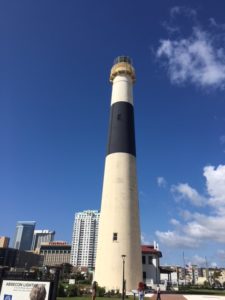
We took a nature boat tour through the wetlands around Cape May at the south end of the Jersey shore. We saw osprey, terns, whimbrel, and so many American oystercatchers. The wetlands are home to many nesting colonies of laughing gulls, and we saw adults and juveniles, fishing along the reedy edges of the marsh grass.

We’ve enjoyed fried shrimp, real New York pizza slices, soft-serve that tasted like a creamsicle, and lots of goodies from the various Italian bakeries. We sampled several flavors at the local peanut butter store, and feasted on another lobster dinner at the Smithville Inn. And last night, Marika grilled peaches for the first time. Boy, are they good with vanilla ice cream and a few local blueberries to cut the sweetness.

This week I’m back to my regular Thursday, Friday, Saturday volunteering shifts. And after Labor Day, the tourists will be gone, and it should start cooling off so I can finally go to the beach.
September will also be my very last month as a Mac trainer, as I am officially closing my mac2School training business after 32 amazing years. It seems a perfect time, as Fall and the Jewish New Year approach, to take inventory of all that I’ve done and been, and what has brought me to where I am, who I am now. I’ve purchased a new domain, ruth-davis.com and I am taking my time to see what that will be. And I am courting several possible volunteer camp hosting gigs for next summer.
We’ll be traveling in October and November, following the changing leaves in New England with stops in Jack Kerouac’s hometown of Lowell, Massachusetts, the famous Cornell Ornithology Lab in Ithaca, New York, and Hawk Mountain in Pennsylvania for the fall hawk migration, then heading south for the winter.
Being with our friend this week has been more than just good fun and even a card game. When you know someone for thirty five years, you really know them, you see how each other has grown and changed and transformed. My friend is a very adventurous traveler. She always has been. I was sharing how I used to be more adventurous and how sometimes I feel like I’m not anymore, and she reminded me that I’m having different adventures, that I’m being brave and adventurous in other ways.
And isn’t that what true transformation is? Doing it differently? Because it CAN’T stay the same AND be a transformation.
I invite you to notice the transformations happening in your own world. Pay attention to the colors around you, when the leaves start to fall off of their trees. And notice what is different about you, in your own skin, in your own life. I’d love to hear about it.
Home Is Where We Park It

Two weeks ago, the air conditioner in the RV finally died. We’d had it serviced for a squeaking noise at the end of May while we were in Memphis. But a few weeks later it started squeaking again, and dripping, and, while Marika was in Philadelphia, the noises became deafening. I made an appointment with a mobile repair company to come on Wednesday. Shortly after Marika got home on Tuesday, it died.
That night, it was 80° outside with 80% humidity, and even moving into the living room for the cross breeze didn’t help. Neither one of us really slept. In the morning we were both tired and hot and the repair guy didn’t come until late in the afternoon. He said we needed a new unit, but that he’d have to order it and come back the next day to install it.
Marika and I had already talked about how much a new unit might be. She had guessed $1200. So when he said $1100. including installation, it was easy to say yes without involving her.
We sat outside under the awning, catching the brief breezes, and watched TV on our phones. I checked in on Facebook, where a friend suggested staying at a hotel for the night. I wondered why we hadn’t thought of it sooner.

So we packed an overnight bag and found a nearby hotel that was pet-friendly. And they had a swimming pool. I was so glad I had packed my bathing suit, and that Marika encouraged me to go swimming, even if the pool was heated.
Because I so needed to be in the water, moving in my body, weightless, then floating, releasing the stresses of the last few days. I needed to feel held as we moved through this ordeal, so that I could support Marika too.
We got a decent sleep, Cody seemed relaxed and comfortable, and I went to work the next morning while Marika waited for the repair people to return with the new air conditioner. They finally arrived around nine at night, in the dark. It was a quick install and we both had a good, deep sleep.
Now we are dealing with a water leak in an outside compartment. Gratefully, it is not leaking inside the RV, which would be a serious problem. The mobile repair guy checked the usual places, but wasn’t skilled enough to further explore possibilities. So today, as you are reading this, we’re driving about an hour north to an RV repair place, where, hopefully, they will be able to fix the problem.
Meanwhile, I’ve settled into the rhythms of my volunteering here. When it’s quiet at the Visitor’s Center, which is 75% of the time, I play games on my phone, read about the area, and last week, I used the time to write some thank you cards.

Marika has been taking care of home stuff while I’m working, but last Saturday she joined me at the Visitor’s Center because none of the other volunteers had signed up. I handled all of the transactions, and she loved interacting with the visitors, and watching the birds at the feeders out the big window. She even brought her lens cleaner and cleaned the loaner binoculars. We both had such a good time that she’ll be working with me most Saturdays.

And on our days off we’ve been exploring the area. We visited nearby Brigantine, a barrier island near Atlantic City. We found a free parking spot on the street and took a quick walk along the seawall, but it was too warm and sunny to be on the beach.

We found the Observation Tower on the north end of the island and Marika saw glossy ibis, black crowned night heron, snowy egret, red winged blackbirds. I sat at the top of the stairs, enjoying the shade and the breeze, and the faint roll of the nearby waves.

We stopped at the Brigantine Historical Society where Margaret Kuhn, one of the volunteers, gave us a tour. She was born and raised on the island and she told us stories of growing up, and of her father, who was very active in the community, especially with the Beach Patrol and Lifeguards.
That’s Margaret in the photo, holding the tray, and today, standing in front of a painting of her father, and a photograph of him next to the first Beach Patrol car that you couldn’t even drive on the sand.


Another day we drove north to Barnegat Light, another beach community famous for Old Barney, a decommissioned lighthouse. We looked around the visitor’s center, then I climbed the 217 steps to the top for a beautiful panorama of the ocean and the bay. My thighs were talking to me for a few days, and I was still so glad I did it.

We’re learning the backroads to the supermarket and visiting different farm stands to find our favorites. We’re enjoying the bevy (I love to use my mom’s name in a sentence) of restaurants, including the Friday Lobster Fest – a 1.5 lb lobster, salad, corn on the cob, and a baked potato – all for only $25.00. And last week we bought live lobsters at the Shop-Rite for $6.99/lb, had them steamed, then enjoyed delicious lobster on our salads for four meals.

This weekend we’re taking the RV up to Philadelphia for a three night visit-the-families weekend. One of my cousins will be in town so a bunch of us will get together, and we’ll spend time with Marika’s aunt and her sons. Of course, we’ll be doing some touristing too.

And then it will be back to work, and our simple, lakeside living. We have a mosquito tent now, so we’ve been sitting outside more, enjoying the quiet and the view. This past week it’s been a little humid and raining, and the mosquitos are in full bloom, but bug spray helps and it makes for fine neighborhood walking weather.

Marika has gone birding along the eight-mile Wildlife Drive almost every day, and once a week, I join her for a shorter cruise around. She loves to watch the skimmers and I enjoy the expansive views, and seeing how much the osprey chicks are growing. This week they are hopping more in the nest, getting ready to fledge and fly. (That’s a green headed fly on the windshield.)

I am so grateful to be here, despite the weather, the bugs, the glitches with the RV. This is the life we choose to be living. And I wouldn’t trade it for anything.
Welcome to New Jersey
One big thing about living on the road is that we never really know how things will be when we arrive at a new place. (Like most of life, really.) And that the fewer expectations we have, the easier the adjustment is. And that, like most things in life, everything changes.

After months of emails back and forth, confirming our arrival July 1, we were asked to come on July 2nd instead, because there would be no staff on site on Sunday to welcome us. So we stayed an extra night in the Poconos and arrived at the Edwin B. Forsythe National Wildlife Refuge on Monday afternoon around two, tired and ready to settle in to our camp site overlooking Lily Lake.
Our volunteer coordinator greeted us and explained that the previous volunteer was still in the campsite, and he was dragging his feet about leaving. We pulled into a shaded parking space, grateful for a half tank of gas so that we could run the generator to use the air conditioning. And we waited.
Like most of the country, New Jersey was experiencing a severe heat wave with very high humidity, so the 95° outside felt like 105° and we were miserable. And because of the extreme heat, the green headed flies that normally stay on the salt marsh side of the refuge, were attacking us.
Green headed flies don’t sting like a mosquito. They bite you with their jagged mouths, breaking your skin. They have an anti-coagulant in their saliva, so the blood drips down for them to eat. The only good thing is that they move pretty slow, so you can swat them, sometimes even before they’ve bitten you. But there are so many of them that a few will get you, for sure. And they are not deterred by the usual bug sprays and remedies.
So instead of walking around, exploring our new neighborhood, we stayed inside the RV, amusing ourselves with our phones on the free and fast wifi. For four hours. We finally pulled into our spot after six, got leveled and started setting up.
Our campsite is in a residential neighborhood, the last property before the actual refuge visiting area begins. It’s on a quarter-acre lot, with a house for interns and a cement pad large enough for two RVs, ours and the other volunteering couple. The rest of the property is a gravel parking lot, and a large area of trees and grass with just a slight downhill toward the lake, perfect for Cody to enjoy lots of off-leash ball playing. We’re about 20 yards from the lake, but a stand of native trees blocks much of the view.

In the evening, Cody and I took a walk down the road, and we found a path through the trees, down to the lake. But as soon as we got near the water, we were both swarmed by green flies, so we turned around and hurried home.

Later, I took him into the grassy area on the other side of our neighbors’ motorhome and kicked the ball a few times. On the way back to the RV I picked up the largest feather I’ve ever seen, longer than my elbow to the tips of my fingers.
“I have a present for you,” I said to Marika when we got home. “Close your eyes and open your hands.” I placed the quill between her fingers. She felt the sleekness of the shaft, then ran her fingers up and down the soft brown and white striped edges. “It’s a feather!” When she opened her eyes she couldn’t believe how long it was.
“I know, right?”
“Could it be a turkey feather?” she wondered.
The next morning she pulled up the curtain on the back window that faces the lake and watched five wild turkeys walk past us in the grass.
That day I had a great Mac client call, and I did laundry in the house next door that is occupied by recent college grads enjoying their first bio-tech jobs. In the afternoon we stopped at a local farm stand and picked up delicious corn and some famous Jersey tomatoes.

And then we drove along Wildlife Drive, the eight-mile gravel road that winds around the salt marshes and wetlands. We saw egrets and shorebirds, gulls and ducks, and stopped to observe the pairs of osprey and chicks on the various platforms along the drive.

It is certainly a beautiful place. Big sky, green marshes, and so many birds. But we couldn’t roll the windows down because the green flies were hovering alongside the car, just waiting to get a bite of us.
On Thursday, we showed up for our first day of work. It was more orientation to the refuge than training. We watched a video, walked through the display room, and did a lot of chit-chatting with our supervisor, Angie, a 29-year old contract worker who is suddenly doing a lot of the work of the recently retired manager, including training the volunteers.
Our working days are Thursday, Friday and Saturday. My job will be to work in the Visitor Information Center with the Friends of Forsythe volunteers, answering questions, selling park passes, as well as ringing up sales in the gift shop. The Visitor’s Center is already staffed with two volunteers from the community each day, and, most week days it’s slow, so they mostly sit and chat, or read, or do crossword puzzles.
Marika’s job was supposed to be a walking rover out on Wildlife Drive, pointing out birds and answering questions. But it is way too hot and buggy for a sane person to be outside, without shade, and with the biting flies, so we will see what else she might do.
After lunch Angie took us on a two-hour drive of Wildlife Drive to learn more about the birds, the channels, and grasses. She also wanted to take some photos of the smiley face helium balloon that one of the ospreys had woven into their nest, and to make sure it wasn’t going to be a hazard for the chicks as they begin to fledge.

I sat in the back seat so that Marika had a better view, and it was hot. There was no window tinting, and not enough air conditioning, and I got a bit car sick. So we came back home so Angie could meet Cody, and I stayed home for the remaining half-hour of our shift and took a nap. Marika went back and stayed another hour, being introduced around, then talking with our other boss about what Marika might do for her work instead.

We found a delicious nearby Chinese restaurant for dinner and talked about things. The weather, the bugs, the lack of work for us. Part of me was ready to up and leave, but where would we go? And then we focused on why we are here: for Marika to spend time with her 87 year old aunt who lives in Philadelphia, about an hour and a half from here. So we agreed to see how the first week goes, and we let go of feeling guilty for not having real work to do.
On the way home Marika squeezed my hand and thanked me for us being in New Jersey. She said she knew that this wouldn’t be my first choice. That we are here for her. For the birds. For her aunt. And I squeezed her back, remembering what this life is all about.
On Friday, it stormed while we were at work. We stood at the big window in the Visitor’s Center and watched the lightning flash over the salt marshes, and marveled at how the purple martins sat outside even with the hard rain coming down.

After lunch Marika met with the maintenance supervisor and she got all the supplies she’d need to paint the back wall of the shop garage on Saturday. He said that, after she’s done painting, he’d find her another project, one at a time.
And I worked my first shift behind the desk with an older, hard-of-hearing woman. I shadowed her, then jumped right in, talking with people, taking their entrance fees to go on Wildlife Drive, even answering the phone and successfully transferring the call. And when Angie said that the e-bird app on the iPad wasn’t always current, I showed her how to refresh the screen and reload the page.
And it was fine and fun, but we only had thirty seven visitors in the five-hour shift, and it is painfully difficult for me to sit and make small talk, especially with people who like to complain about things.
That night I had a meltdown. I cried for an hour, not knowing how I was going to survive three months of boredom, with such heat and humidity, and not being able to walk anywhere because of all of the bugs. I hated having to check Cody for ticks after every walk, and, even though we are on the coast, we are an hour away from a public beach. And, on top of all of that, I was out of marijuana, the one thing that calms me when I feel so out of whack. Before I went to bed, I asked the Universe for a way to be OK with being here.
On Saturday we woke to big breezes, 62° and very low humidity. It was almost chilly. The sky was summer blue and there were no mean greenies around the camp. It was so pleasant that I was able to walk the half-mile to the Visitor’s Center for my shift, past the wild turkeys in the trees and a turtle crossing the road.

I worked with two retired men who showed me how to empty the self-pay boxes, and where the supplies are kept for the outside port-a-johns. We had 167 visitors throughout the day and I had fun. I sold lots of park passes and Duck Stamps, and learned how to fill out the special sheet for disability passes. And mostly, I enjoyed talking with the variety of people. And Marika had a good time painting, in the shade, while listening to NPR.
On Sunday, our first of four days off, Marika drove up to Philadelphia to spend a few days with her aunt. Marika hasn’t seen her aunt in eight years, and she is sad to see that her memory has deteriorated, she is no longer driving, and she forgets to get dressed, unless someone reminds her. They ate pizza, bought lots of goodies at the German delicatessen, and visited the cemeteries where most of the friends and family are buried.
Cody and I enjoyed being home in the still-cool and dry weather, and we even sat outside in the evenings, watching the wild turkeys move through the woods. And I ordered a mosquito tent so we’ll be able to sit outside, even when it gets warmer and buggier.

And there is a lot to see in the area. There’s a wind farm that offers tours, lots of local produce stands, and a small museum in Atlantic City, about an hour south of us. We’re going to look into getting a seasonal beach pass for one of the smaller, quieter beaches about 30 minutes from here, so that I can walk along the rolling surf and feel grounded.
Yes, some days are going to be painfully slow and boring. And yes, I’m going to like working with some co-volunteers more than others. But it is only for three months. And it really is a beautiful place. And Marika is loving all of the birds, even if it is through rolled-up windows.

Traveling and Touristing
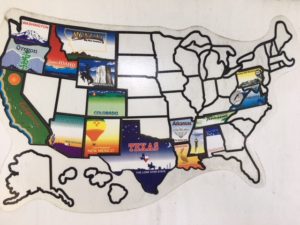
We’ve been traveling and touristing these past two weeks, learning lots, and adding more state stickers to our map.
After getting the air pressure checked in both the RV and the car tires, we left camp near Staunton, Virginia and got back on I-81 for an easy 1-hour drive north across the state line into West Virginia. We followed the Garmin’s directions 9 miles off the highway, along a narrow two lane road that curved and climbed, and just wide enough to stay in my lane, in no hurry to drive the posted 55 mph.
At the end of the road we turned into the campground, a huge non-working farm, with campsites in a grassy field along a creek that was lined with deciduous trees, all in their summer greens.

We leveled and hooked up, had lunch, and then planned to drive 35 minutes back south to Winchester, Virginia, to the Museum of the Shenandoah Valley where a Facebook friend works. She had set aside two free passes for us. So we put on our going-into-town clothes and got ready to leave.

But then I heard the thunder, and I wanted to stay home to enjoy the storm. And what a storm it was. I sat at the dinette and watched the wind pelting the rain against the driver’s side of the car. I was so glad we were parked with the RV facing into the wind, not getting hit broadside, because we could feel movement, even as stable as we are.
And then there was a crack of thunder, so close that we could feel the floor rumble. And I was glad we were home. And finally we both agreed to just stay home, since the storm was moving in the direction we were headed, and there were red lines of traffic on the Maps app on the highway we needed to take.
So we took off our going-out clothes, got back into comfortable shorts and t-shirts, and listened to the rain. It lasted almost an hour, a hard downpour with wind, then just heavy rain. And then it stopped, and we all got in bed. I even napped.
Later, we put on our hiking boots and took a walk around camp, along the gravel road that circled a huge field of two-foot high grass, partly mowed. We turned down the loop road under the trees that paralleled the wider part of the creek. There were a couple of tent campers, a muddy path down to the water, and mosquitoes.
Cody and I turned around and headed back for the open road and continued around the circle, committing to the full walk around camp. We got to the top of the hill, just past the office and it started to rain. Lightly at first, and then, just as we made it to the cover of the gazebo, it came down hard. We sat on a bench on the side of opposite where the wind was blowing and stayed dry.

On the walk back to the RV, I saw Marika sitting under the group pavilion. Cody and I walked across the thick, wet grass to join her, then we all made it home before the next downpour.
The next day was a touristing day. We started from camp in West Virginia, took the highway north, briefly back into Virginia, and then across the Potomac River into Maryland. It was storming too much in Williamsport, so they cancelled the Canal Boat Tour, the reason we had come.
After our picnic lunch in the car, instead of just coming home, we continued along the roller coaster backroads, stopped for ice cream in Sharpsburg, then drove over the Potomac River again, into Harper’s Ferry, West Virginia, where we had planned to go to the John Brown Wax Museum to learn about the abolitionist. But there was no parking in town, so we switched drivers and headed home, with the Avoid Highways setting on the GPS.

We drove up and down the luscious green hills, with rolled bales of hay scattered randomly across the fields, past brick and siding houses sitting atop sprawling ranches. We passed a highway crew riding mowers along the precarious sloping shoulders, another truck using a 6-foot electric hedge trimmer because the angle was so steep.

We slowed down as we drove through the small old towns, the barely two lane streets lined with clapboard homes next to original brick business buildings next to wooden slatted walls that used to be homes, the vines and trees now taking over the structures.
The next day we drove back into Virginia to meet my friend at the museum and we loved walking through the gardens, seeing the Lego sculptures and the Asian Garden. And we especially enjoyed meeting a new friend and sharing some lovely conversation.

Last weekend we finally left the Virginias and arrived in Pennsylvania. Our campsite was across from the playground at a very kid-friendly campground, but it served as a good base for exploring. We drove 45 minutes north and west, across the Susquehanna River, to the Broad Street Market in Harrisburg.

Broad Street Market is the oldest continuously operated market house in the US. We got a loaf of sourdough bread, cherries, and sugar peas. We shared an Amish pretzel, which is much softer and more buttery than the favorite Philadelphia pretzel, and we sat outside listening to a black guitarist singing in an unrecognized language.
A mix of locals and tourists passed by, moving between the 1874 brick building and the 1863 stone building where there were more food vendors. We watched a pair of moms with their 6-8 year olds sit and listen to the music, one boy with Down syndrome, moving his hands to the music, slightly off beat. A black woman in her 60’s pushed a two-wheeled cart and steered it over to an older black man sitting on a bench. Did you hear Ole Man Tex died? Yeah, heart attack. I heard. Yeah.
And it was an easy blend of black and white, locals and tourists. So different than in the south where we knew we were either in a white neighborhood or a black one.
We drove down Front Street, along the river, past stunning old mansions with varied architectural styles, many now converted to businesses and apartments. And we drove across a bridge and walked around City Island Park until it started to rain.
And now we are in the Poconos in central Pennsylvania for the week. It is green with hills and trees and a big, wide, ever-changing sky. It is barely humid, divine in the shade, and so quiet you can hear the birds and the breeze. The high today should be in the high 70’s.
And now we are in the Poconos in central Pennsylvania for the week. It is green with hills and trees and a big, wide, ever-changing sky. It is barely humid, divine in the shade, and so quiet you can hear the birds and the breeze. The high today should be in the high 70’s.
Last night I was sitting outside under the awning, with my phone, taking pictures of the sky, and a camper asked me about the wifi service. She is hiking the Appalachian Trail, and using this campground as a base for the next 50 miles. She’s in her 50’s/60’s and is traveling with her dad in a Chrysler van. He drops her off and picks her up after she walks the next 10-15 miles of the trail each day. I clapped my hands and gave her a big WooHoo.
Her trail name is Van Hailin, because she’s traveling in a van and she hails her dad for a ride. She started in Harper’s Ferry three weeks ago and will walk to the north end in Maine, then drive back to Harper’s Ferry to walk the south section to Georgia, where she’ll meet up with her kids. I said, Wow, they must be so proud of you. And she said, No, they think I’m crazy. And then I gave her a second round of applause, because Damn! She is hiking the entire 2184 miles of the Appalachian Trail!

And this is what I love about this lifestyle. We meet people who are doing things that they love, that bring them into nature, that spark something in their heart.
Yesterday we drove into the next big town to get haircuts, and we both enjoyed the easy conversations with our stylists. We had fun exploring the world’s largest Shop-Rite supermarket, and found the sweetest strawberries at a local farm stand. And we found a real bagel place and took home a baker’s dozen! There are a few touristy things we want to do, and later this week, we’re getting together with Marika’s mom’s old neighbor who now lives up here.

This is the perfect place to rest and relax between the last two months of traveling, and the next three months when we’ll be in one place, with a regular work schedule, volunteering at a National Wildlife Refuge in New Jersey. It’s a wonderful opportunity to slow down and breathe and say thank you for all that we’ve seen, and done and experienced to get to this place, right here, right now.
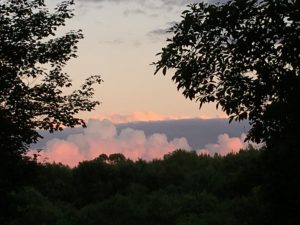
Traveling Through
We left muggy Memphis but, instead of turning north, we agreed to stick with our Alabama itinerary, to see a few touristy things along the way.
We ate pretty good BBQ at a Bait and tackle shop in Tupelo, sang some Van Morrison, and stopped at the Natchez Trace Visitor’s Center before heading to camp at a private RV park outside of Muscle Shoals.

After we settled in, we drove into the town of Florence, through the semi-abandoned downtown area, with whole blocks of boarded up storefronts. We passed the warehouse district near the Port of Florence and followed the signs through several old neighborhoods to Helen Keller’s birth house.

I enjoyed our tour guide, Miss Anne, who wore a ring with the Alabama quarter on it. The quarter features Helen Keller and it’s the only quarter with braille writing on it. She made the ring herself.
Miss Anne commented on the artwork on my t-shirt, two hands with the fingers making the shape of a heart, and she touched the white heart stone that hung from a silver chain around her neck.
She said, “The artist who made the marble sculpture outside of Helen and Annie at the pump made us all hearts from the leftover marble.”
After the museum we drove through the beautiful old neighborhoods with thick trees and just-cut lawns, oohing and aching at the mix of bungalows and farm houses, restored and gorgeous.
And then, right in the middle of the neighborhood, we pulled into a big parking lot of what used to be a church or school, that is now a visitor’s center for the famous Rosenbaum house built by Frank Lloyd Wright. We opted to skip the tour and just walk around the outside of the house.

It was dark wood, with well-disguised hinges and door handles. The house was a series of boxes with the expected panels of windows only at the tops of the room. The roof overhangs were especially low, and, being in the shadow of the mature summer trees, the house seemed like it would be very dark inside. I peeked through the windows and it was furnished just like Taliesin West, in Scottsdale, Arizona, with the low built-in bench seating covered with simple, solid colored cushions, and the same dining table and chairs.
One of my long-time Mac clients studied and worked with Frank Lloyd Wright and, at 88, is still active with the FLW Foundation. I emailed him a photo of the house, and his partner, a textile artist, replied that he had met Mrs. Rosenbaum many years ago in a weaving class. She was having trouble, and he helped her thread the loom. They became friends and my clients visited her in the house. He said, “She was quick to say that her son was conceived on their first night living in the house.” I doubt that information is included in the tour.
We marveled at the houses across the street, then continued driving through the neighborhoods, to a city park along the Tennessee River where I had considered camping. It was big and crowded, and I was delighted to see that the place we chose was much better.
We stopped at a second park and looked out over Pickwick Lake, the body of water created by the Wilson Dam. We drove through the Tennessee Valley Authority complex, following the brown signs for the Alabama Bird Trail, and parked at the trailhead for a short nature loop. Marika was content to watch the thrushes in the trees in the parking lot, and I followed the trail into the forest. But after a few yards in, I was suddenly too hot and sticky, so I turned around and found a bench under a tree with a view of the water, and watched a family packing up their picnic lunch.
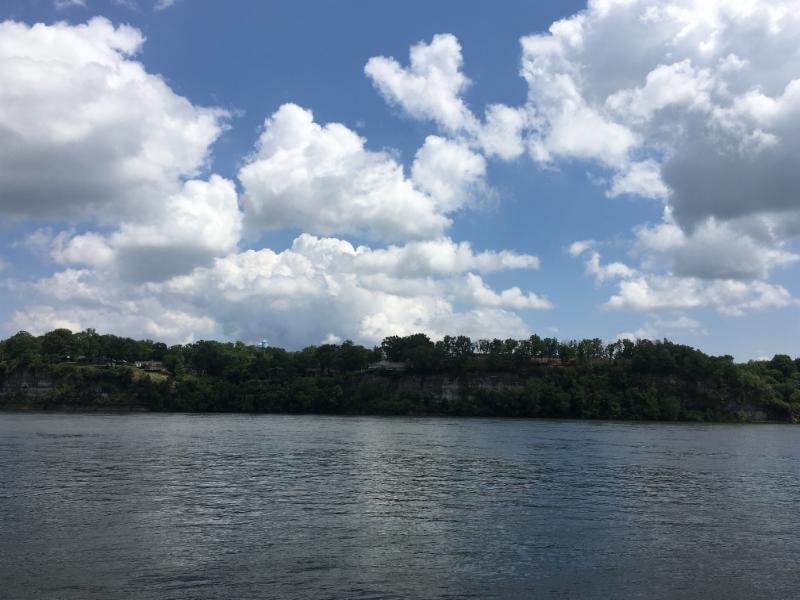
The next day we drove an hour, met a friend for lunch, then drove another hour to our county park campground where we quickly set up camp and then headed out to the Unclaimed Baggage Store. The store is a giant thrift store, clean, bright and neatly organized, with all kinds of clothing, jewelry, and stuff that folks have lost in their travels. I found a lovely pair of sterling silver earrings.

After a quick overnight, we drove to Oak Ridge, Tennessee, the secret city from WWII. The city of Oak Ridge was built as part of the Manhattan Project, to find ways to separate plutonium and uranium to make an atomic bomb. It was fascinating to hear about the lives of the workers living in a city surrounded by fences, forbidden to talk with each other about their work. We took the bus tour around the facilities and even saw the Graphite Nuclear Reactor.

We spent a full morning at the Museum of Appalachia, built and curated by a man who collected millions of artifacts and had original cabins and buildings moved to this property so you really get a feel for life back then!
All around the grounds, there are original wooden shack houses with 1.5 inch thick wooden floor planks as wide as a tree, a schoolhouse, a church, blacksmith and saddlery, jail cells, even Mark Twain’s family cabin, most filled with the original furnishings from the structure when it was found.
There were carved out wooden troughs used for salting pork, and three-foot wide metal bowls used to filter salt out of the water they had to carry from 20 miles away.
We read stories of the people of Eastern Tennessee in the late 1800’s through the 1960’s, many matched up to photographs of the teller. There were rooms filled with homemade banjos and dulcimers, cloth dolls and dinner-calling horns. There were whittled tools and toys and animals, and a room with caskets and a carved, wooden, horse-drawn hearse.
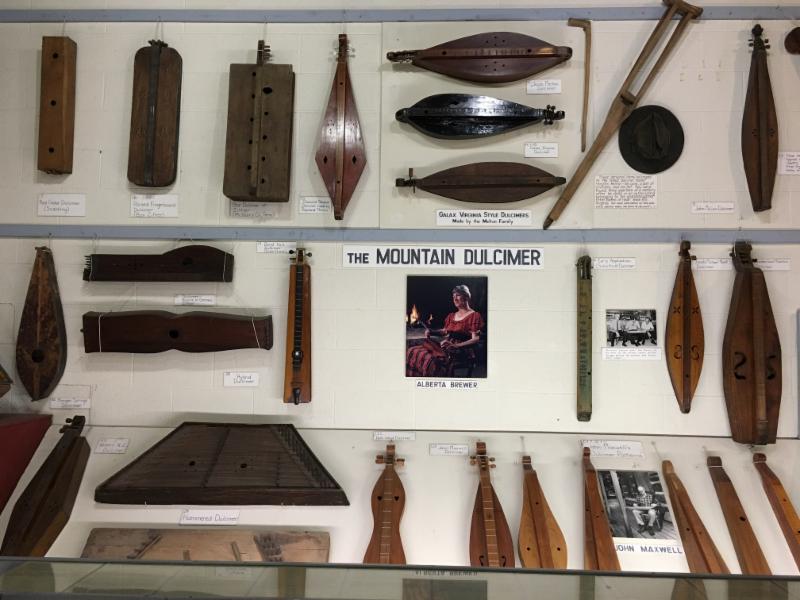
Each display was documented with printed signs and handwritten notes, initialed in the corner, as if to verify their authenticity.
The cafe there served lunch, and Marika had her first pimento cheese sandwich, which she enjoyed.
After lunch we went to the Green McAdoo Cultural Center to learn about the Clinton 12, 12 black students who went to the local white high school in the fall of 1956, when desegregation became the law.
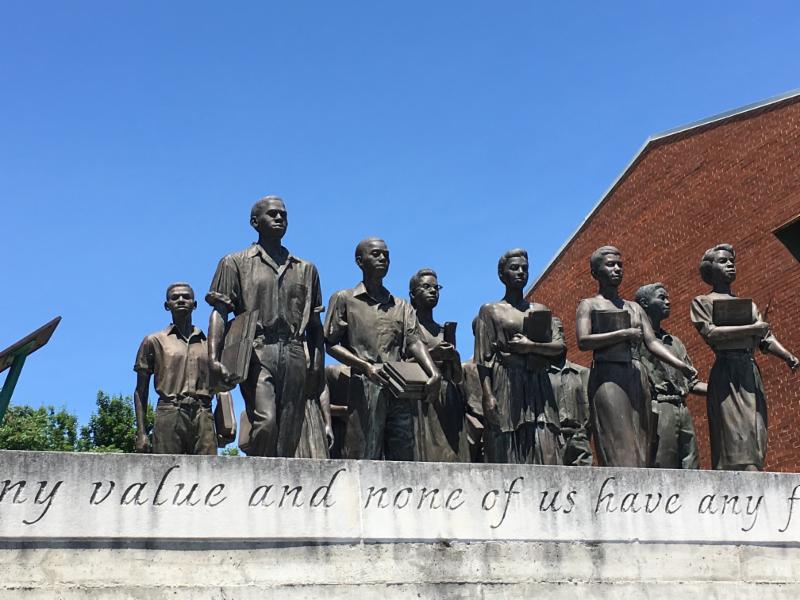
We talked with Miriam, the docent who was born after segregation. When Marika asked if she preferred being called Black or African American, she said, “I like black. African American implies that we had a choice. And nobody from Africa back then had no choice.”
Marika asked if things were any different now and Miriam said, “You know who likes you and who doesn’t. There’s no hiding it anymore. Just last month there was a Ku Klux Klan rally in Knoxville.”
And now we are in Virginia, slowly making our way north through the rolling green of the Shenandoah Valley. We visited the Edith Bolling Wilson Museum in Wytheville, pronounced Withville, and learned about the 35th First Lady, married to Woodrow Wilson. We bought fresh ground beef and lettuces at a small farmers’ market, and watched hundred of robins around the campground.

The temperatures are cooler, and, even with the rains, it is less muggy. Yesterday I even wore a sweatshirt!
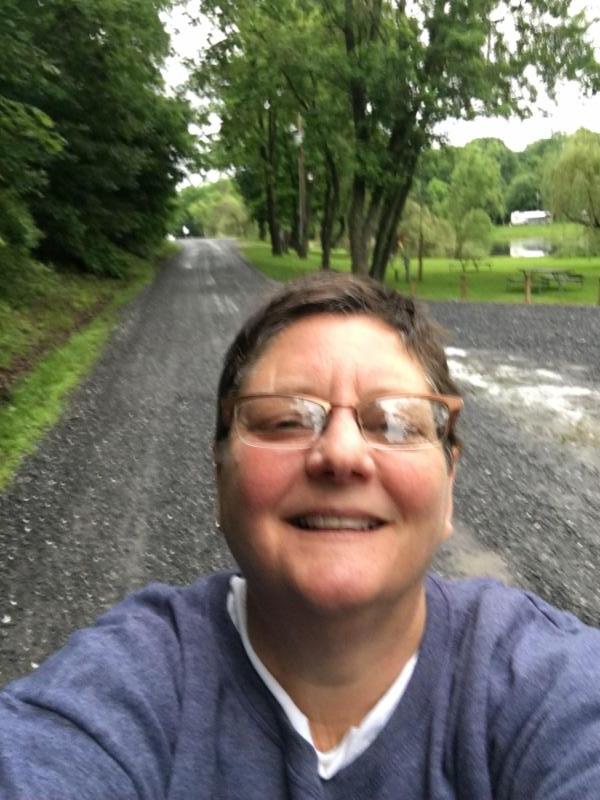
Today, we’re just hanging out. Even though there are touristy things all around, sometimes we just need to have a day at home, to relax, regroup, and just be. Tomorrow we’re getting together with a friend from Camp, then continuing north toward the Poconos fo a week before heading to New Jersey.
I can’t believe we’ll be working at our summer volunteer gig in just a few weeks, parked in one place for three whole months. It will be such a change of pace and rhythms and scenery. This is one of the many things we love about living on the road.
Muggy, Buggy Memphis
We’ve been in Memphis, Tennessee this past week, first a few miles north of the city at a state park in the thick of the forest, and now, at an RV park in West Memphis, on the Arkansas side of the Mighty Mississippi.
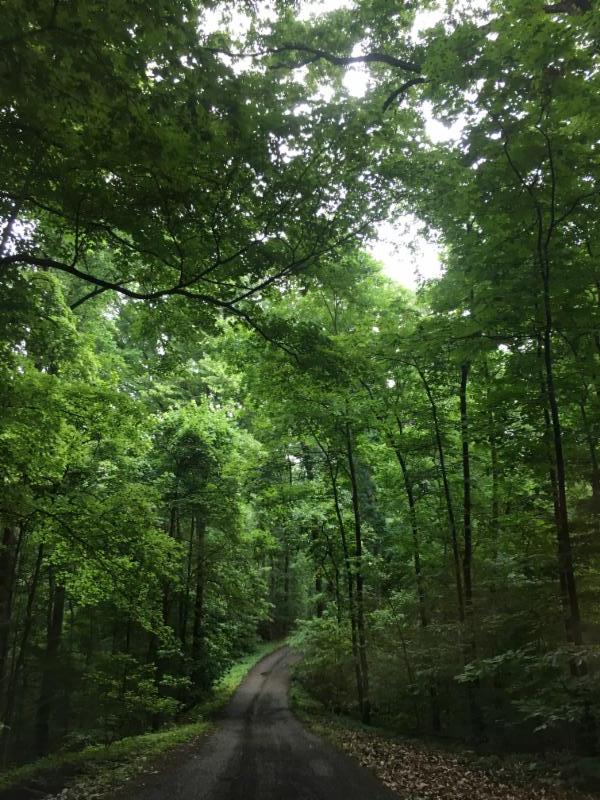
The forest was so dense that we had no cell signal, no TV reception, no wifi. Yes, it was beautifully green, but it was so incredibly muggy and buggy, that we mostly stayed inside, playing dominoes and reading. For people who have full and busy lives with very little quiet, offline time, this might seem like heaven, but it was very challenging for us. We drove into the nearby town twice, just to get out of the dark, oppressive woods.
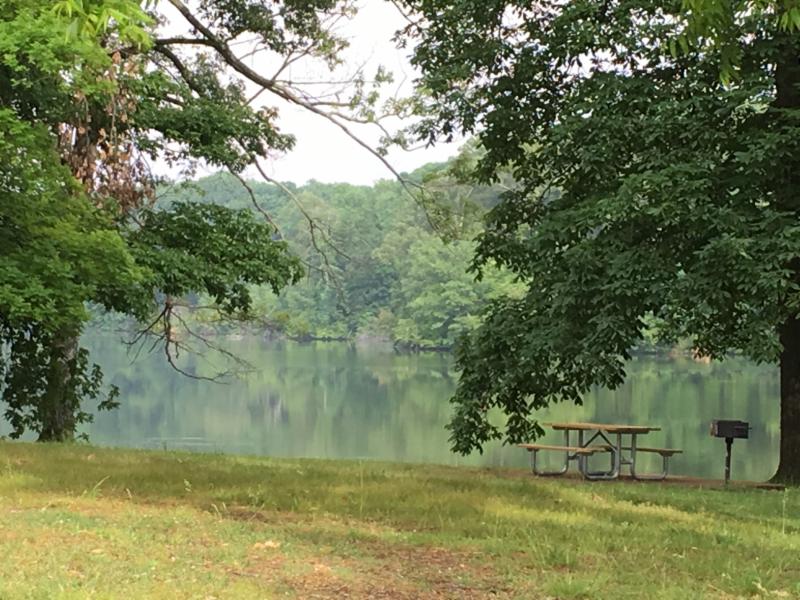
In the early evening we drove through the park, to the boat ramp on the Mississippi River. There was no place to walk or sit, so we drove over to the larger of the two lakes in the park and walked around, looking for birds. I had two bars on my phone, so I came back the next day for a coaching call. It was warm, even in the shade, but not unbearable, since I was sitting still. But after a while, even the bug spray wasn’t keeping the mosquitoes away, and I was glad to get back to the air-conditioned RV.
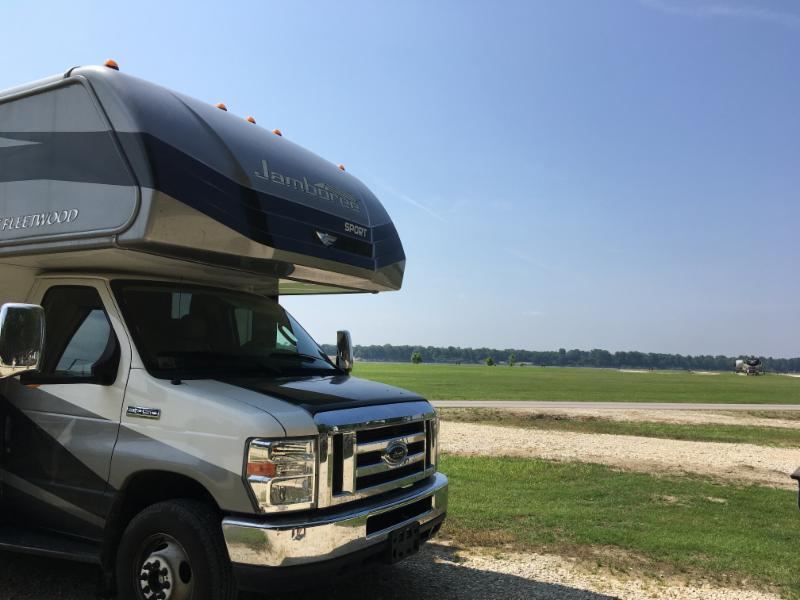
After three nights in the trees, we drove closer to Memphis, and are now staying at a private campground right on the Mississippi River. We have a wide open view of the sky and the river and the barges going up and down.
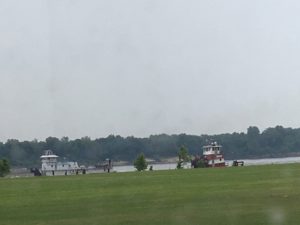
And Cody has a huge grassy field to play in. Every day the sky fills with rain-promising clouds, but it always passes, leaving us in a blanket of thick, muggy air. But, thankfully, as moist as the air is, there are no bugs, because the city sprayed the area the day before we arrived.

But we’ve gone out in it. We visited the Slave Haven Underground Railroad Museum. Underground, as in Undercover. Railroad, as in many stops. The guided tour was a telling of the horrific slave trade, and slave conditions, and how the man who owned this house had to pretend to have slaves in order to blend in and not raise suspicion.
We learned the secret codes of the quilts that the runaways used to find the next safe house. We saw the tunnels under the house where they crawled in, and stood in the basement hiding room where they waited until a safe boat was coming up the Mississippi to take them further north.
We went to the Cotton Museum and Mud Island and learned about the history of life on the Mississippi River, then took a riverboat cruise in the afternoon.
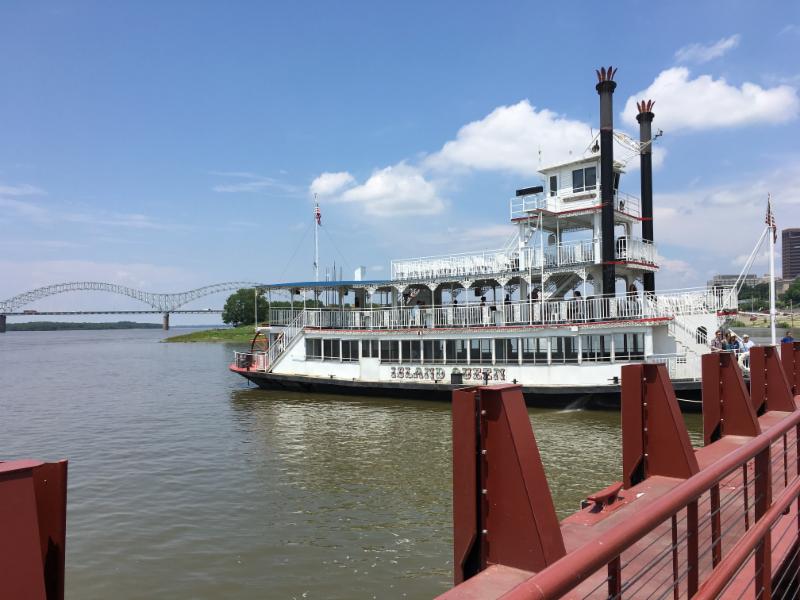
We sat in the middle tier which was shaded, but there were no fans or a/c, not even a slight river breeze. And we were on that boat for two and a half hours, on the edge of heat exhaustion. And so we cancelled the rest of our sightseeing plans for the week.

On Sunday, I attended the Open Heart Spiritual Center’s Celebrationwhere I was invited to speak again. I received the invitation the Monday before, and I had gone into pure panic mode–What would I talk about? How would I connect to their monthly theme? How could I possibly be ready on such short notice?
I kept myself up that first night in crazy thinking. In the morning I started writing down all kinds of thoughts, thrilled for the opportunity, and terrified that I wouldn’t be ready. And then a dear friend suggested that just telling my story might be inspiration enough, that I didn’t have to turn it into an obvious teaching thing.
And then I was able to breathe. I wrote some more, and started to get excited about it all, knowing that, by Sunday I’d be all-in. I found the story to tell, with a beginning, middle and end, and I had clarity about what I wanted to leave my listeners with. I took a walk and talked it out loud, and just like that, by Saturday evening, I was ready.
And it was amazing. Not just my offering, but being in community with people I knew, with singing and hugging, and so much heart sparking. And right there, in the middle of my speech, I realized, out loud, that I want more of this kind of connection.
Now I know that I can find these kinds of Sunday celebrations all along our travels. Not just as an opportunity to speak, but for me, the person who craves this kind of heart connection.
We’re leaving Memphis tomorrow, spending a few days in Alabama and eastern Tennessee for some touristy things, then we’re heading north, out of this humidity. I’m not sure yet what route we’ll be taking, but we’re watching the weather as we decide.
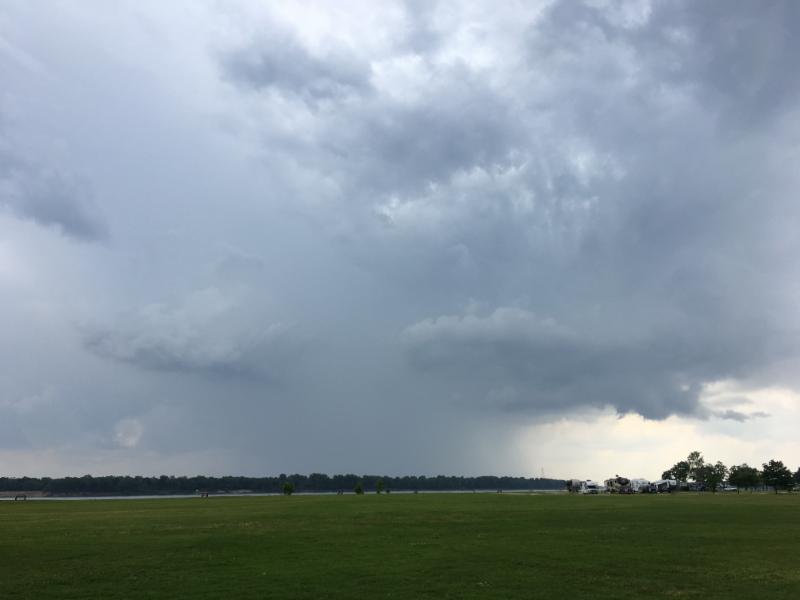
Click here for the link to the video of my talk at Open Heart Spiritual Center.
And here are links to some of the songs I’ve been singing since we’ve been here. I hope they put a smile on your face and a spark in your heart.
Joni Mitchell’s Furry Sings the Blues
Marc Cohn’s Walking in Memphis
Paul Simon’s Graceland
On the Road, with Chimpanzees
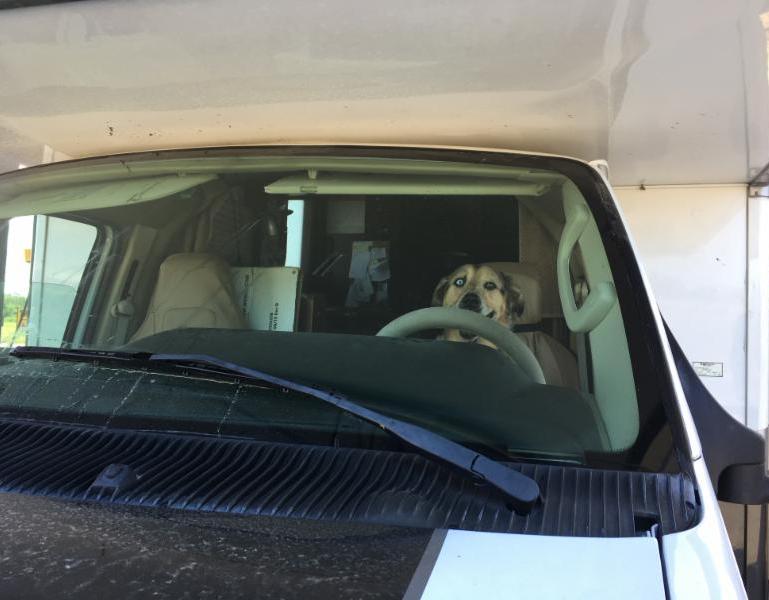
All is well with the transmission pump and we are officially back on the road. After a muggy weekend at a state park near Jasper, we finally left Texas and added a new state sticker to our map.
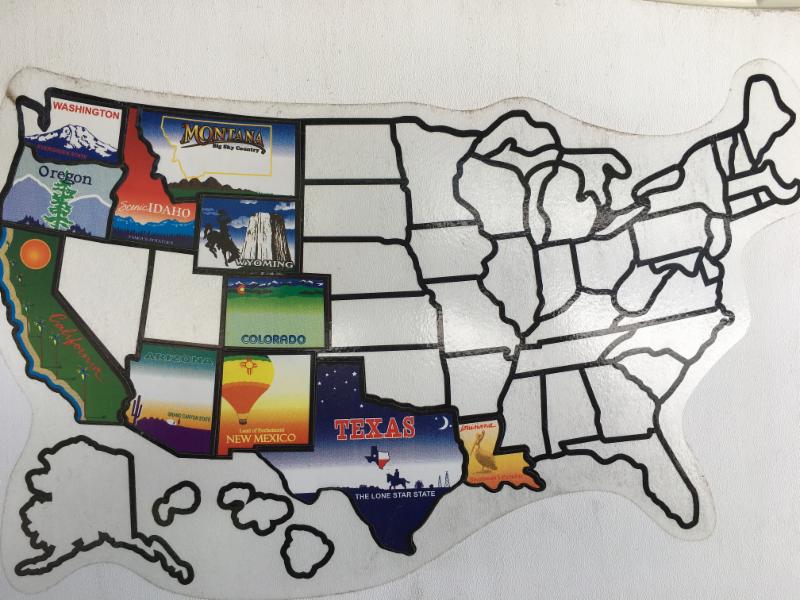
We’re spending a week in Bossier City/Shreveport, Louisiana, so that we can volunteer at the nearby Chimp Haven, a sanctuary for chimpanzees who were previously part of biomedical experiments. There are 260 chimps at the sanctuary, and they are building more compounds for the 200 chimps still in labs across the country.
As volunteers, we’re helping with food prep and making enrichment snacks. We have no direct contact with the chimps. Only a handful of doctors, behaviorists and medical personnel have any interaction with them. Everyone else needs to stay at least six feet from the enclosures for safety, because chimps are aggressive and strong, and they will throw feces at you if they don’t know you.
Amy, our volunteer coordinator, drove us around the facility, explaining that, when the chimps arrive, they are studied and assessed, then assigned to a family group of about 21 chimpanzees. Some of the chimpanzees prefer having access to the forest and outdoor habitats. Others won’t leave their bedrooms without enticement, and only feel safe with a roof always over their heads.
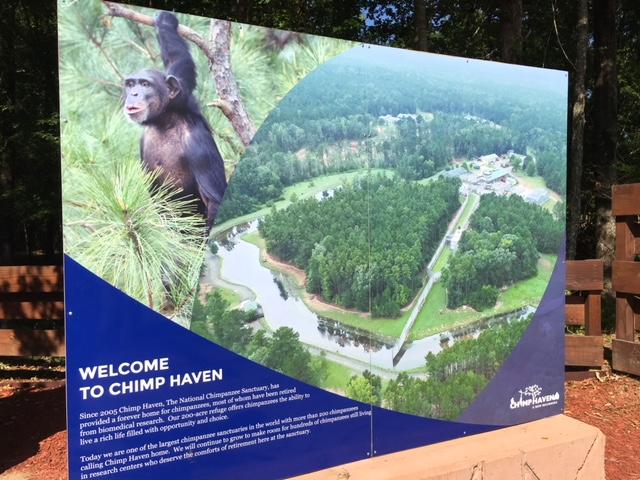
We saw several chimps lumbering in the grass, and others moving between their enclosures. They scream and bang things and keep an eye on the people working around the facility.
After the tour and safety lessons, we put on masks and gloves to protect the chimpanzees from any germs we may be carrying, and went to work. We stuffed bananas into PVC tubes with bigger-than-finger sized-holes. The tubes will be frozen, then hung on the mesh of the enclosures for the chimps to enjoy.
We mixed together industrial-sized cans of vanilla pudding, mandarin oranges and pineapples, then spread it inside a PVC U-joint. They’ll also be frozen, then hung on a chain from the mesh.
We got to see a chimp being wheeled out of the medical room on a gurney, and then we walked over to the food storage area, an air-conditioned hangar-like building with walk-in refrigerators, freezers and several pallets of biscuits specially formulated for chimpanzees. There was a full-sized garden shed with wall-to-wall metal shelves of huge jars of peanut butter, family-sized bags of peanuts, and industrial-sized cans of fruit cocktail, applesauce and pudding.
There was a stainless steel counter with three sinks, and two long tables where we worked. We cleaned recycled plastic drink bottles, then filled them with a mixture of Cheerios, raisins and a sugar-free maple syrup. We chatted with a few staff people, and then filled some more bottles with frozen blueberries, grape syrup and water.
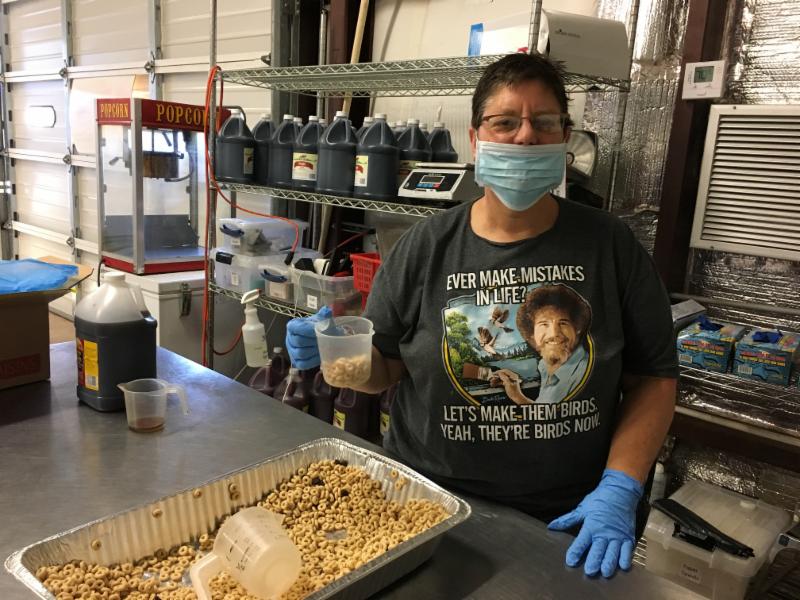
On our second day we finished making the blueberries juice bottles, then squirted the same grape syrup and water mixture into Boomer Balls, hard plastic balls with three bowling ball finger holes drilled out. The juice balls are frozen and the chimps love scraping out the slush. The biggest challenge of the job was to stack the balls in 5 gallon tubs in the freezer without the liquid spilling out.
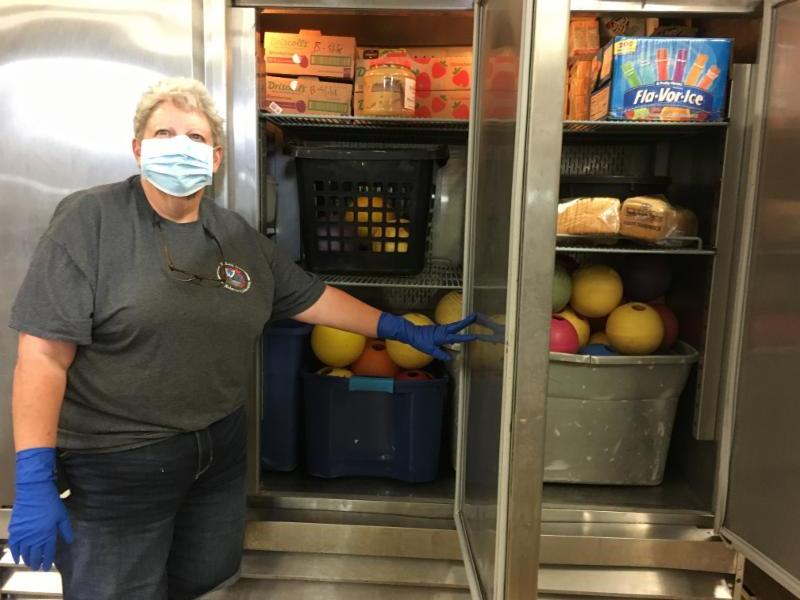
After our lunch break we made a foraging treat, stuffing finely chopped pieces of apricot between the bristles of a utility broom. The chimps have to separate the bristles to find the fruit, mimicking their grooming behavior.
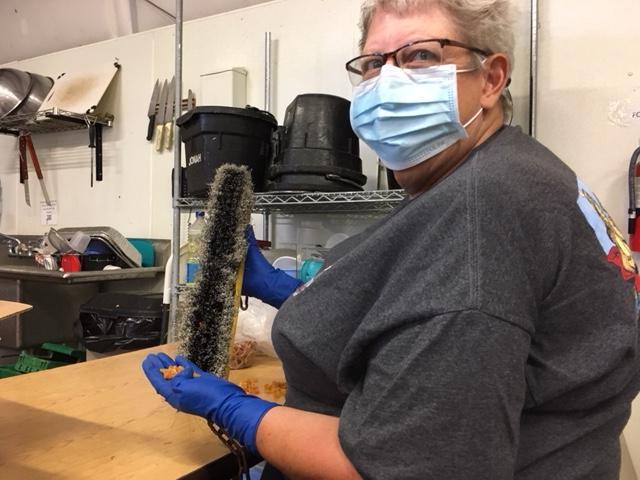
Marika asked if we could come a little earlier on Thursday and do another drive around to really observe some of the chimps, and Amy said, “Absolutely.” And then she asked if we wanted to do a feed throw, tossing some of the enrichment treats into the compounds. So tomorrow, we’ll get a great look at more of the chimpanzees, and watch them literally enjoy the fruits of our labors.
We only work half a day, then come home to relax and hang out with Cody. In the evenings, I’ve been luxuriating in the RV park swimming pool, and last night, Marika had her first taste of real barbecue. Next week we head to Memphis, where we’re meeting up with a friend to explore the area and sample more barbecue. I’m hoping this unseasonably hot and humid weather passes so that we’ll be able to enjoy some outdoor time.
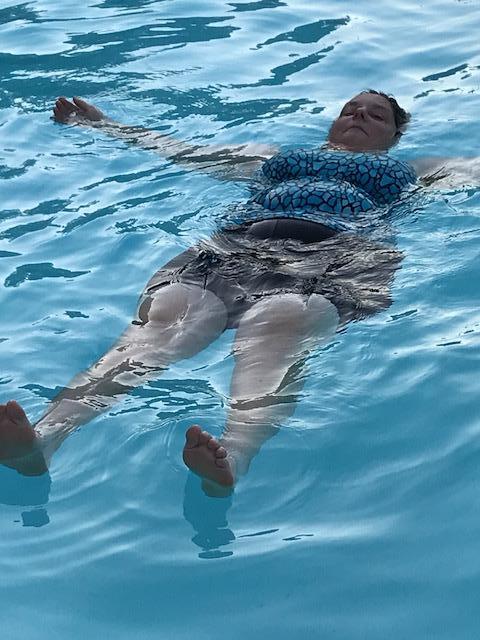
It’s great to be back on the road, seeing new places, enjoying new experiences. And it’s really nice to have a place to show up and be of service. Free time is great, but we both need some structure and purpose in our days, or we can get mighty cranky.
Finding the balance seems to be the key.
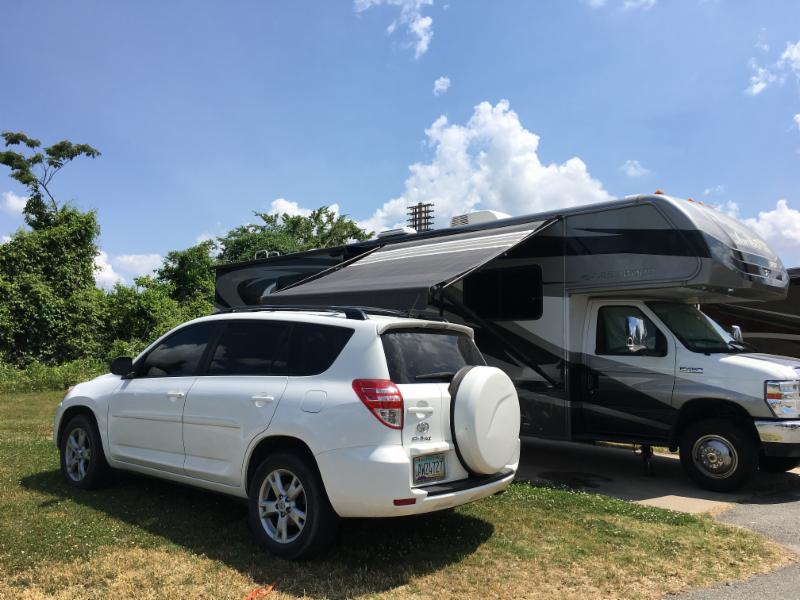
When Freedom is Lonely

We’re in the last week on the coast and it’s been glorious. I’ve been to the beach twice a day, every day, sometimes with Cody, sometimes alone, even a few times with Marika. Most days I pick up litter, watch the pelicans, and do modified sun salutations at the water’s edge. Weekends are getting busier and noisier, with more trucks and golf carts and families on the beach. This past Saturday we enjoyed a fireworks display right out the living room window.
Marika has gone birding almost every day, and she has seen more varieties of birds, and so many new birds, than ever before. Already we are talking about returning next spring.

I’ve been reading and writing, making postcards and binge-watching Netflix, really enjoying the feel of being on vacation. And one day last week we drove to Port Arthur for a day of touristing. We visited a Buddhist Temple, and the Museum of the Gulf Coast, drove around the refineries, and ate no-frills Vietnamese food.

But here’s the thing about all of this freedom: it can get pretty lonely.
Marika is gone most days, from early morning to late afternoon. And when she comes home, she updates her bird lists, studies her bird book, and then lies down in front of the TV because she’s had a day.
And that truly is wonderful. For her.
But I’ve been alone all day, and I am starving for someone to engage with.
Yes, I’ve chit chatted with the RV park owners, and waved and said hello to several neighbors. But I haven’t had a real conversation about anything deep and meaningful with someone in weeks. Or so it feels.
Of course I keep in touch with friends in Phoenix. But a quick catch-up phone call, or a back and forth email conversation is not at all the same as a three-hour in-person sitting together, with several full-on body hugs sprinkled in.
So I’ve been spending a lot of time crying, feeling sorry for myself, and aching for community and connection. One morning, after I posted a picture on Facebook of my morning beach walk with Cody, and hinted at my loneliness, a friend shared how the water is always healing for her, like a mother.
And so I walked back to the beach, but, instead of focusing on picking up litter and counting steps, I walked to the edge of the water, looked out at the low gentle rolls, allowing the cool water to wash over me. I stopped thinking and feeling and simply opened to healing.

And again, of course, I remembered that I am responsible for my own happiness.
And so, as I plan our route for the next few weeks, I’m making sure we visit some friends along the way, so that I can get some much needed in-person time with real people, and real hugs.
When we leave the coast on Sunday, we have to return to Houston to deal with the transmission pump in the RAV4 AGAIN, because the alarm won’t stop alarming, which means we can’t tow it. Maybe it will be a three-minute fix, maybe a three-day fix. So we’re keeping things loose until we know.
Once the pump is fixed, we’ll begin our travels north and east toward Washington D.C. We’ll spend a few days in Lufkin, Texas visiting with a friend, then we’ll be in Shreveport, Louisiana for a week. We’re volunteering at Chimp Haven, a refuge for chimpanzees who were the subjects of testing and experimentation. Marika has been a supporter of the organization for years, and has dreamed of volunteering there, even though you don’t have contact with the chimps. We’ll be chopping food, cleaning buckets, folding laundry, and who knows what else. And we’ll be able to observe the chimps in their open-space habitats, simply being chimps.

We’ll spend a few days in Memphis to hug another friend, visit some museums, and restock at Costco. And then, who knows.
The last three weeks of the trip are still unmapped. The calendar is marked with stretches of lines marked “Someplace” and “Someplace else,” so that we have space and time to enjoy the traveling, to explore off the highways, to not know exactly where we’re going until we get there.
If you’re along our route (we’ll be traveling north of I-40, staying on smaller highways, heading to D.C.), let me know. I’d really love to get together!

